| The Classical Guitar Tutorial for Beginners | ||
|
|
||
| Chapter Two: Stringing Your Guitar | ||
|
When should you change your guitar strings? There is no definitive answer to this question. You have to pay attention to your strings. When you have a new set of strings notice how bright and vibrant they sound. As your strings wear they will get a dull sound. If you play for an hour every day you probably should be changing your strings every one to two months. If you play eight hours a day you will be needing to change them weekly.. The natural oils of your fingers will shorten string life. You should always wash your hands before playing. If your strings show signs of wear such as black spots where the frets are then they need to be changed. the metal bass strings will even show signs of corrosion. That is a sure sign to change your strings. note: It is very important that you use only classical guitar strings. They are nylon and metal wound. Never use folk/rock guitar strings this will damage your guitar. I prefer using strings made by D'addario. After you have removed the old strings it is an opportune time to clean the guitar. Use a soft cotton cloth to wipe it down thoroughly; Inspecting for cracks and any problems like loose frets. I recommend you use a very light coat of a polish specifically made for guitars. I use Martin Guitar Polish. |
||
 |
Martin
Guitar Polish Specially formulated for fine instruments. Comes in 6 oz fine Spray pump bottle. |
|
|
|
||
| Changing The Guitar Strings | ||
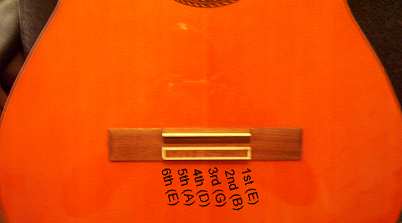 |
||
|
Here are the locations of the six strings and their
names. The paper sheath that the strings are wrapped in say what string
it is.The sixth string is the thickest and the first string is the thinnest.
I will show you how to do the sixth string.
|
||
|
Remember we are doing the sixth (E)string here. This is the thickest string. Feed it over the bridge then though the hole and feed it though so about two inches of string is sticking out . |
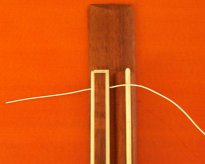 |
|
|
Take this two inches of string and curl it up over
the Bridge base then tuck it under the string.
|
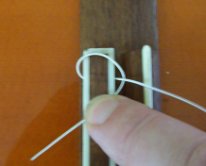 |
|
|
.
|
||
|
Insert this end under the string. Under the loop you
just created. It should look like this.
|
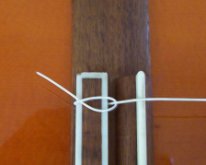 |
|
|
Curl it around again and tuck it under again. This double loop insures it will not come loose. For the three thickest strings you do this double loop and the three thinnest strings you should triple loop. |
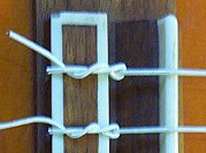 |
|
